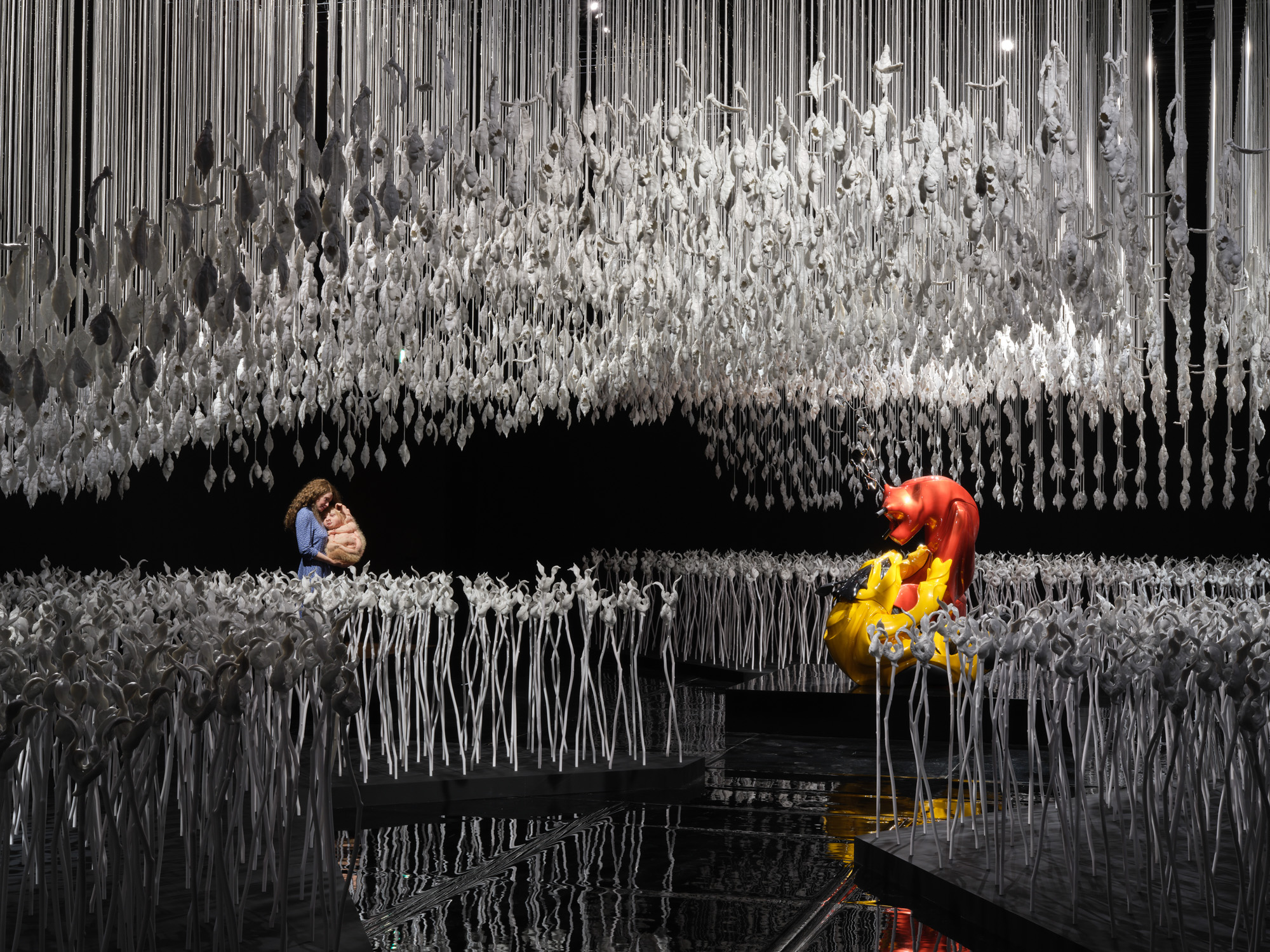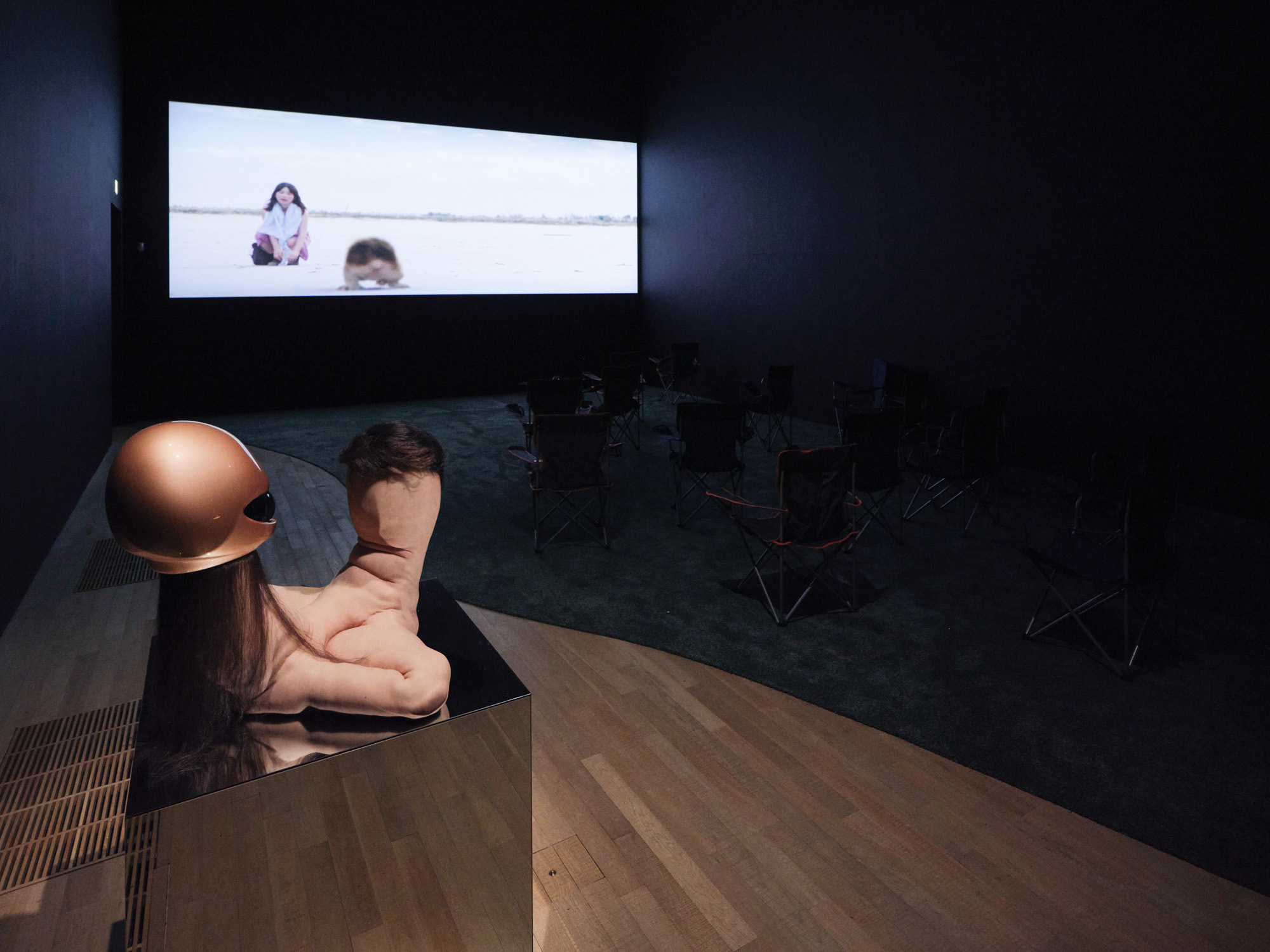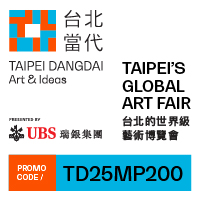Roundtable Review: Patricia Piccinini’s “HOPE” at Tai Kwun Contemporary
By The Editors

Installation view of PATRICIA PICCININI’s Kindred, 2018, silicone, fibreglass and hair, 103 × 95 × 128 cm, at "HOPE," Tai Kwun Contemporary, Hong Kong, 2023. Photo by South Ho. All images courtesy Tai Kwun.
Curated by Tobias Berger, “HOPE” is a solo exhibition of Australian artist Patricia Piccinini, best known for her surrealistic and hyperrealistic works. Comprising sculptures, video works, and paintings, the show presents Piccinini’s distinctive vision that encourages viewers to reflect on the implications of humanity’s scientific, technological, and environmental interventions. ArtAsiaPacific's editorial team members offer their perspectives on the large-scale presentation.
“Too ambitious, yet not ambitious enough”
Going to the exhibition, I knew what to expect of the art and what the artist expected of me. The hairy silicone statues were going to elicit discomfort, even revulsion, but what was expected was compassion and empathy. Still, the initial shock of seeing hairy white flesh that straddled animals and humans—and, strangely, shoes—caused the intended disgust. In turn, I felt a sense of self-disgust—why could I not immediately overcome this dislike and find the sculptures “strangely cute” or “surprisingly endearing?” For a show aimed at the public, it felt far too ambitious, and yet somehow it was not ambitious enough. The combination of nature, technology, and humans with bulging blobs, orifices, and sagging sacks were an easy recipe for repulsion. Together with the invocation of genetic engineering, the sculptures manifested their designed discomfort. Despite their repelling effect, the imaginative “unreality” made the stakes non-existent. If the viewer did not come away from the exhibit finding compassion within their heart, no one would be hurt. If the viewer found a way to overcome their initial reaction, the effect did not necessarily transfer over to issues currently faced by real people. Discomfort with the existence of “the other” was only metaphorical, merely a mental exercise. The self-congratulation of finding the sculptures charming allowed visitors to continue along, reassured and comforted that they were not prejudiced without confronting those whom society treats with contempt. GRACE JEFFERD

Installation view of PATRICIA PICCININI’s The Offering, 2018, silicone and hair, 12 × 24 × 28 cm, at "HOPE," Tai Kwun Contemporary, Hong Kong, 2023. Photo by South Ho.
“Vaguely provocative”
“HOPE” was yet another Tai Kwun summer blockbuster show featuring a mid-career Western woman artist whose oeuvre is vaguely provocative but within the parameters of bourgeois middle-class sensibilities. The solo presentation of the Australian artist Patricia Piccinini was framed as a response to the convergence of the artificial and the natural, resulting in a dystopian posthuman end. It seemed that the curatorial intent was to lean into body horror and the question of whether science had gone too far, but ultimately visitors were presented with, for example, The Offering (2018), a furry palm-sized neonatal silicone chimera that one could hold. When compared to body horror classics, such as The Fly (1986)—which, by the way, is being screened at one of the concurrent events related to this exhibition—Videodrome (1983), or the novelty Human Centipede (2009), the “body horror” presented in this show lacks the visceral abjection and defensive cognitive dissonance one typically expects from the genre. But to those used to seeing Monet or other Impressionist-adjacent exhibitions, some of Piccinini’s works might cause one to be uncomfortable. If one ignores the way the show craves to be “edgy,” one will find an enjoyable, cozy, and cute exhibition that can be shared on social media, especially with the display of Celestial Field (2021). TIFFANY LUK
.jpg)
Installation view of PATRICIA PICCININI’s Celestial Field, 2021, multiple plastic objects, false floor, suspended ceiling grid, multichannel audio, dimensions variable, at "HOPE," Tai Kwun Contemporary. Photo by South Ho.
“Overly didactic curatorial approach”
Theoretically, it seems hard to dissociate Patricia Piccinini’s works from abjection, as they not only intend to disturb aesthetic and social conventions but further materialize dystopian, post-anthropocentric, and posthuman narratives. Her works also draw on some of the most popular notions in contemporary art discourse, such as bioart, posthumanism, and democratization of aesthetic standards. However, the curation of her solo exhibition at Tai Kwun failed to acknowledge the complexity of her work or its intentions to address these significant notions. The bead curtains—a possible tribute to Felix Gonzalez-Torres—forbade viewers to contextualize or draw associations between individual pieces, and the pastel painted walls disturbed people while revealing the curatorial suggestion of acceptance and care for the Other. The overly didactic curatorial approach made it hard not to end the viewing experience with the endorsed optimistic tone. In other words, it was difficult to conclude anything other than “hope,” especially with Celestial Field (2021) and We Travel Together (2021) being showcased on the top floor near the end of the exhibition. For an artist as complex as Piccinini, there is much more one could explore than presenting an idea as vaguely as “HOPE.” But I must admit this summer show—cute, cozy, tangibly fun, and easy to explain—is highly recommended for its family-friendly nature. XIYUN WU

Installation view of PATRICIA PICCININI’S The Loafers, 2018, silicone, resin and hair, 26 × 25.8 × 25 cm, at "HOPE," Tai Kwun Contemporary, Hong Kong, 2023. Photo by South Ho.
“Flirted with oversimplification”
“HOPE” at Tai Kwun dedicated three floors to Patricia Piccinini’s silicone and human-hair creations, a synthesis of sci-fi movie props and Classical sculpture. The show disarmed the viewer with waves of attraction and repulsion, a concept cleverly introduced by The Offering (2018), a tiny, hybrid animal swaddled in fur for visitors to touch upon entry. From the start, viewers were forced to accept the disconcerting duality that the small, vulnerable creature they hold is entirely man-made. The Loafers (2018) epitomizes this dichotomy in their enchanting ugliness, their humorousness and innocence, and their closeness which evokes the artist’s focus on inescapable connections between living things. The myriad themes Piccinini’s work explores inevitably posed challenges for the curatorial team, as with any signifcant survey, but the choice to bring these disparate elements (family, love, genetic modification, shoes, reproduction, gender, mopeds, pollution, etcetera.) under the banner of “surrealism” flirted with oversimplification. Piccinini’s work, though strange, does not emerge from surrealist randomness or the unconscious; it is specific, grounded in realism, and extremely charming. Wrestling with this incongruous categorization may detract from the delicate tonal and emotional dance these imagined beings play out so effectively. Either way, Tai Kwun set out to introduce a provocative and stimulating cross-section of Piccinini’s work to the public, and they undoubtedly achieved that. BRYNN GORDON

Installation view of PATRICIA PICCININI’s We Travel Together, 2021, single-channel video with sound: 10 min, at "HOPE," Tai Kwun Contemporary, Hong Kong, 2023.
“Confusing curatorial direction”
With her hyper-surrealist, grotesque body of work in the spotlight, Patricia Piccinini’s solo show spoke to our anxieties of the rapidly progressing biotechnical sphere, focusing particularly on the idea of the Other. The idea of “hope,” offered by the exhibition title, felt incongruous to what was on display—one could even argue that without the title of “HOPE,” the viewer could have a much different takeaway from the exhibition. At first, her sculptures might have seemed unsettling; Piccinini’s utilization of human hair, hyper-realistic features such as freckles, wrinkles, and even veins may elicit disgust from the faint-hearted. An eerie piano lullaby, which played in the background, underscored the body horror of Piccinini’s work. But as one came to accept these odd creatures, the show achieved its objective of encouraging empathy. Looking beyond the surface, however, one would find that the exhibition’s execution did not reach its full potential. Piccinini’s works and their complexities were explored in the show, albeit shallowly. All three of the show’s main exhibition spaces were designed differently, as an attempt to present the multiple facets of Piccinini’s oeuvre, but they repeated the same theme and subject throughout its displays. Despite the show’s confusing curatorial direction—compounded by the lack of wall text and the reliance on the exhibition booklets to provide context—the feel-good film We Travel Together (2021) provided an effective conclusion. CHERYL KWAN

Installation view of PATRICIA PICCININI’s No Fear of Depths, 2019, silicone, fibreglass, human hair and clothing, 150 × 150 × 110 cm, at "HOPE," Tai Kwun Contemporary, Hong Kong, 2023. Photo by South Ho.
“Affection, curiosity, repulsion”
I had seen many images of Patricia Piccinini’s works but not very many in reality, and the encounter with them is more unexpected and revealing than I anticipated. Because her sculptures are so meticulously hairy and so fleshy—like the pair of conjoined twins, The Loafers (2018), who have the cuteness of two baby rodents and hairlines of Donald Trump—you often find yourself vacillating between affection, curiosity, and repulsion. The one “chimera” carried around by a gallery docent, the one you are encouraged to touch, known as The Offering (2018), is a furball with a wrinkled pig’s face and delicate baby lips. It’s strange how you have to remind yourself that it is an artwork—something dreamed up to push your buttons while you’re pressing your fingers into its cheeks. I have “hope” that these odd, strange, curious creatures inspire people to think about what a human is and what an animal is, and the posthuman fuzziness around these lines (this is a city, after all, where you often see small-sized dogs dressed in “cute” outfits being pushed around in strollers). As scientists give us more insight into animal consciousness, we’re starting to feel greater sympathy and kinship with the animal kingdom, coinciding with a time when humans are changing their borders and definitions of the self. What I enjoyed about seeing “HOPE” were all the moments that Piccinini made me feel a bit squeamish: the video of “hanging organisms”—testicular bats—In Bocca al Lupo (2003); the oracular orifice in The Awakening (2020) giving birth to an eye and/or limb and/or creature. More than just discomforting, Piccinini’s works make you think about your own place in the world, in your physical meat-body, and just how wondrously strange that is. HG MASTERS
HG Masters is ArtAsiaPacific’s deputy editor; Tiffany Luk is associate editor; Grace Jefferd was assistant editor; Brynn Gordon, Cheryl Kwan, and Xiyun Wu are editorial interns.







